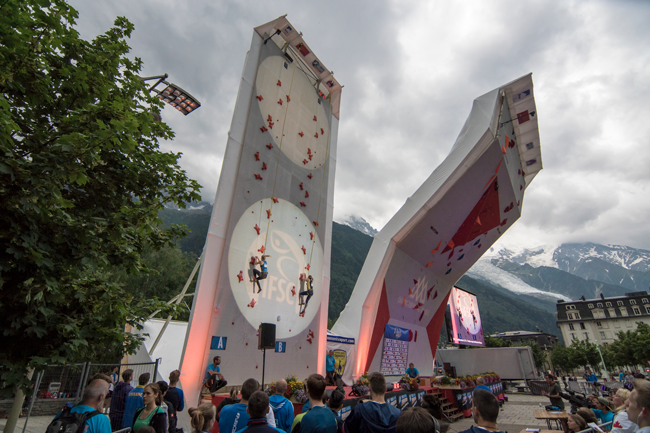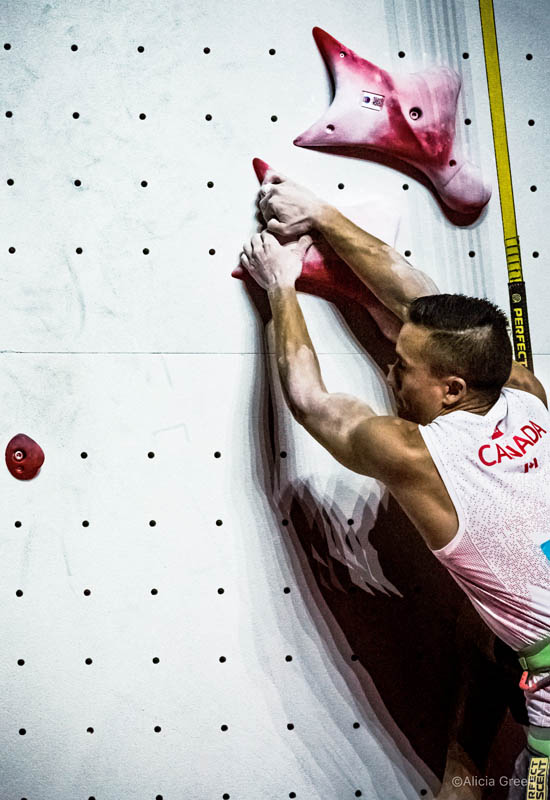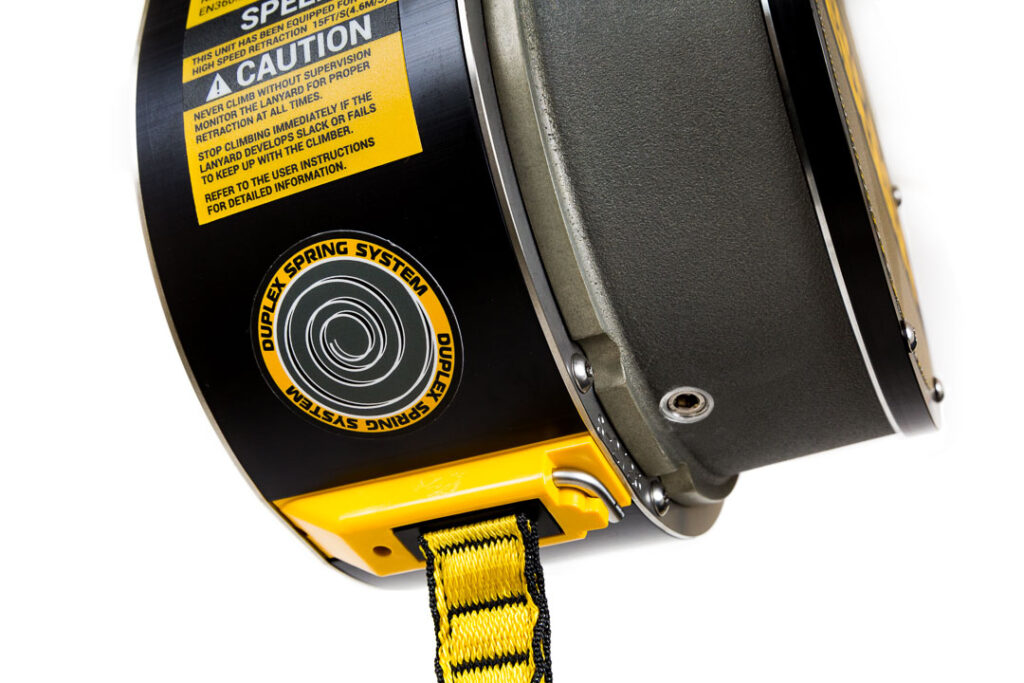Explore/Past Posts
Newsletter Sign Up
How the Perfect Descent Auto Belay Changed Speed Climbing Forever
Speed Climbing made its Olympic debut, the even playing field is more important than ever
Originally Published on Climbing.com

Imagine this: Olympic sprinters take their marks at the starting line for the 100-meter dash. The pistol cracks—and they’re off! But wait: We suddenly realize that each lane is different. Usain Bolt’s lane is tilted uphill! He quickly falls back nearly a second as one of the other runners—whose lane is on a downward slope—easily coasts to victory.
Sounds crazy, right? As spectators, we naturally assume that, for a race that comes down to hundredths of seconds, things are standard for everyone, with every little variable accounted for. But, believe it or not, in the sport of speed climbing, which is having a moment right now after its debut at the Olympic Games in Tokyo, this wasn’t always the case. (Don’t worry—it is now! More on that later.) Not because the wall wasn’t standardized (it was and still is), but because the rope and belayers were variables that simply couldn’t be standardized.

Sean McColl, a 33-year-old Canadian climber who logged a personal best at the Olympic Games with a time of 6.93 seconds on the 15-meter speed route, remembers how “with human belayers, we the speed climbers were never sure if the rope would be to our left or to our right.”
And that was just the tip of the iceberg. Piper Kelly, one-time holder of the women’s American speed-climbing record, and whose fastest time is currently 8.4 seconds, says that sometimes, if the belayer wasn’t fast enough, a loop of slack might develop: “My knee or arm would go through the loop and interfere with my climbing.” Additionally, if a belayer was super quick—creating what Kelly calls “inconsistencies with rope tension”—they might be giving the climber an unintended lift! And Kelly, 21, has seen it all, having competed all over the world, from China to Russia, Austria to Italy, Panama to Ecuador.
But in 2016—everything changed for speed climbing.
Enter Perfect Descent Auto Belays. While auto belays had been around for a while, none of them were practical for elite-level speed climbing, as these other devices were woefully slow. They simply couldn’t retract the lanyard (most auto belays use a lanyard rather than a traditional climbing rope) fast enough to keep up with the speed climbers.
Perfect Descent’s auto belay represented a paradigm shift. With a retraction rate of 4.6 meters per second, even the world’s fastest speed climbers could climb without having to think about whether their belayers could keep up.
“Perfect Descent was not the first auto belay I saw, but they were the best,” says McColl. “When they came out they were smaller and more functional than others out there and just worked better.”
” [Perfect Descent] created a sort of reassurance for the athlete, that everything was safe and standard, so that definitely increased the number of athletes participating and led to more speed specialists.”
Jérôme Meyer, Head of Olympic Coordination at the IFSC
The International Federation of Sport Climbing (IFSC) formally announced Perfect Descent’s Model 220 auto belay—since renamed the Speed Drive™—as the exclusive officially sanctioned device for speed climbing events in September 2016. The IFSC observed positive reactions instantly, among competition organizers and athletes alike.

Jérôme Meyer, Head of Olympic Coordination at the IFSC and a past competitor himself with four Bouldering World Cup gold medals to his name, says, “On our side, it simplified competitions, made them easier to watch, easier to organize.” He says Perfect Descent’s adoption “created a sort of reassurance for the athlete, that everything was safe and standard, so that definitely increased the number of athletes participating and led to more speed specialists.”
Meyer also says using auto belays was a significant factor in getting climbing into the Olympics. “There’s always a matter of perception,” he explains, “so when the IFSC switched to Perfect Descent auto belays, making everything cleaner and safer, it definitely helped with that outside perception. The safety element definitely had an influence.”
So, back to the Usain Bolt and 100-meter-dash analogy: What did Perfect Descent mean for fairness?
Aleksandra “Ola” Mirosław, the 2018 and 2019 speed climbing world champion and the women’s speed world-record holder after a blistering fast time of 6.84 seconds at the Tokyo Olympics, sums it up well: “Now everyone has the same conditions.”
With the standardized retraction rate that could keep up in instances where other auto belays fell short, and without the latent discrepancies found in human belays, Perfect Descent leveled the playing field for all competition speed climbers.
It reduced speed climbing to its essence. John Brosler, the men’s speed American-record holder, with a time of 5.6 seconds, and 10-time National Champion, explains that “The Perfect Descent auto belay takes up slack, it doesn’t get in the way, and you forget about it—and that’s exactly what you want.”
While it impressively improved fairness issues, perhaps the Perfect Descent Speed Drive auto belay’s biggest revolution was in speed climbing safety.
Back in the days of human belayers, two individuals would tandem belay the speed climber, with one belayer pulling rope from above and one belayer pulling rope through the belay device. Brosler says that system “worked for a little while, but then people started getting too fast for it to be safe.”
“I’ve seen videos of people being dropped,” Brosler says—a result of belayers working feverishly to keep up with the climbers, and therefore making mistakes. “It’s not the belayer’s fault,” Brosler adds, “but that belaying style is just not safe.”
In fact, At the 2018 U.S. National Championships in Reno, Brosler’s own (human) belayer actually fell over. (While much of the competition world had already switched over to auto belays, adoption was not yet universal.)
Mirosław says that the Perfect Descent auto belay eliminated the “human factor” in terms of safety.
“The way that the Perfect Descent auto belay finally standardizes things around an already standardized route is, I think, something that is really beautiful,”
Sean mccoll, professional climber & olympian
Old fuddy-duddies in particular might scoff at the idea of relegating safety to a little mechanical device. But, McColl notes, even when there are non-speed-climbing auto-belay accidents at regular climbing gyms these days, almost all of them are the result of someone failing to clip in properly—i.e. human error.
Perfect Descent Speed Drive auto belays have a back-up system built in to prevent catastrophic failure of the devices, what McColl terms a “double-clutch system” for the lanyard. In technical speak, the Perfect Descent Speed Drive relies on a two-stage centrifugal brake mechanism. “If the initial mechanism fails,” McColl says, “the backup system kicks in.” And the coolest part? The climber would never even know: If the primary brake fails, the backup forces the brake pads to engage, and the climber is lowered without any hiccups.
And while that backup means you’re doubly safe on the way down, there’s a failsafe to keep you doubly safe on the way up, too. All Perfect Descent models have the company’s proprietary Duplex Spring™, meaning that the lanyard retracts even if a spring fails, rare as that is.

In the few years since Perfect Descent arrived on the scene, speed climbing has catapulted from the fringes of the climbing world to front-and-center as the world’s best climbers raced head-to-head in the Olympics. The new legitimacy it has leant the sport— based around perceptions of fairness, safety, and reliability—is critical.
“Speed-specific auto belays have helped a lot with making speed climbing more legitimate,” Piper Kelly says. “Regular gyms can now have the exact same system for athletes to train on that they will use in competition. It has made my own training much easier.”
Mirosław agrees. “It is a huge relief, because it used to be hard to find two additional people to belay for each training session.”
So, while the general populace might be more familiar with the 100-meter dash than speed climbing going into Tokyo this summer, by the 2024 Paris Olympics—when speed climbing will debut as a standalone medal event, no longer paired with bouldering and lead climbing—spectators will surely know about this exciting sport.
“The way that the Perfect Descent auto belay finally standardizes things around an already standardized route is, I think, something that is really beautiful,” McColl concludes.
